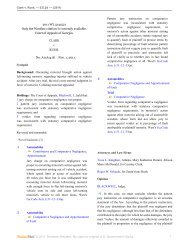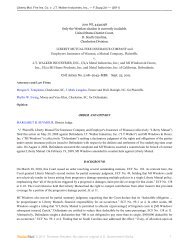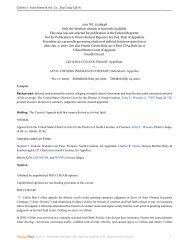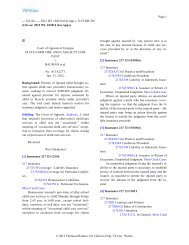American Family Mutual Ins. Co. v. American Girl - Insurance ...
American Family Mutual Ins. Co. v. American Girl - Insurance ...
American Family Mutual Ins. Co. v. American Girl - Insurance ...
You also want an ePaper? Increase the reach of your titles
YUMPU automatically turns print PDFs into web optimized ePapers that Google loves.
673 N.W.2d 65 Page 20<br />
268 Wis.2d 16, 673 N.W.2d 65, 2004 WI 2<br />
(Cite as: 268 Wis.2d 16, 673 N.W.2d 65)<br />
coverage.<br />
[30] *56 78 The court of appeals affirmed, but<br />
did so because of the contractually-assumed liability<br />
exclusion in the policies. We have rejected the court of<br />
appeals' interpretation of the contractually-assumed<br />
liability exclusion. We agree, however, with the circuit<br />
court's conclusion that the professional services<br />
liability exclusion in the excess policies excludes<br />
coverage.<br />
79 Renschler's <strong>Co</strong>mmercial Blanket Excess<br />
Liability Policy contains the following endorsement:<br />
Professional liability exclusion.<br />
<strong>Ins</strong>urance under this policy does not apply to any<br />
liability arising out of the rendering of or failure to<br />
render professional services in the conduct of your<br />
business or profession. (Emphasis in original.)<br />
80 It is undisputed that Lawson's inadequate soil<br />
engineering advice was a substantial factor in causing<br />
the excessive soil settlement and resulting property<br />
damage to the 94DC. Renschler is responsible to<br />
Pleasant for the flaws in Lawson's professional services<br />
pursuant to the broad warranty in the construction<br />
contract. Accordingly, the liability here arises out<br />
of the rendering of professional services, and by its<br />
terms, this exclusion applies.<br />
81 Pleasant and Renschler argue that Leverence<br />
v. United States Fidelity & Guaranty, 158 Wis.2d 64,<br />
462 N.W.2d 218 (Ct.App.1990), compels a contrary<br />
conclusion. Leverence involved claims by homeowners<br />
against a builder whose negligence in the construction<br />
of their homes caused **85 excessive<br />
moisture retention, which in turn promoted the growth<br />
of hazardous mold, mildew, fungus, and other toxins.<br />
The builder's insurer argued that the professional<br />
services liability exclusion in the insurance policy<br />
barred coverage.<br />
*57 82 The court of appeals disagreed, concluding<br />
that because “the claims arise out of manufacture<br />
of an allegedly defective product and not<br />
malpractice in rendering of a professional service,” the<br />
exclusion did not apply. Leverence, 158 Wis.2d at 83,<br />
462 N.W.2d 218. The court declined to separate the<br />
builder's professional design services from its con-<br />
© 2011 Thomson Reuters. No Claim to Orig. US Gov. Works.<br />
struction services for purposes of evaluating the applicability<br />
of the exclusion: “to break down [the<br />
builder's] activities into separate components, and<br />
then bar claims arising out of its manufactured product<br />
because intellectual skills were employed would go<br />
beyond the normal rules of contract interpretation.” Id.<br />
at 84, 462 N.W.2d 218. The court noted that<br />
“[a]lthough the homes' design allegedly contributed to<br />
the claimed injuries, the primary objective of [the<br />
builder's] operations was the production of a prefabricated<br />
home, not a design of a home,” and therefore<br />
the professional services liability exclusion did not<br />
apply. Id. at 85, 462 N.W.2d 218.<br />
83 The court in Leverence cautioned, however,<br />
that it was not concluding “that nothing constitutes a<br />
professional service [within the meaning of the exclusion]<br />
if it results at some point in the production of<br />
a commodity,” giving as an example the rendering of<br />
architectural design services in connection with the<br />
construction of a building. Id.<br />
84 We conclude that this case falls outside the<br />
holding of Leverence. While it is true, as Pleasant<br />
notes, that Renschler furnished a building, the liability<br />
at issue here “arises out of the rendering of professional<br />
services”-Lawson's faulty site-preparation advice-which<br />
falls squarely within the language of the<br />
exclusion. This case thus does not pose the analytical<br />
dilemma that troubled the court in Leverence; there,<br />
the professional services inextricably combined with<br />
the *58 manufacturing services to produce the claimed<br />
injury. Here, it is undisputed that flawed professional<br />
soil engineering services were a substantial factor in<br />
causing the excessive soil settlement and resultant<br />
property damage to the 94DC. Accordingly, we conclude<br />
that the professional services liability exclusion<br />
in <strong>American</strong> <strong>Family</strong>'s excess policies applies.<br />
G. The four other insurers<br />
[31] 85 Renschler also had insurance policies<br />
from four other insurers: Ohio Casualty <strong>Ins</strong>urance<br />
<strong>Co</strong>mpany and West <strong>American</strong> <strong>Ins</strong>urance <strong>Co</strong>mpany,<br />
which issued CGL and excess liability policies respectively<br />
for April 1, 1997, through April 1, 1999,<br />
and General Casualty <strong>Ins</strong>urance <strong>Co</strong>mpany and Regent<br />
<strong>Ins</strong>urance <strong>Co</strong>mpany, which issued CGL and umbrella<br />
liability policies, respectively, thereafter. The circuit<br />
court held that the known loss or loss-in-progress<br />
doctrine precluded coverage under all of these policies.<br />
FN9 We agree.






